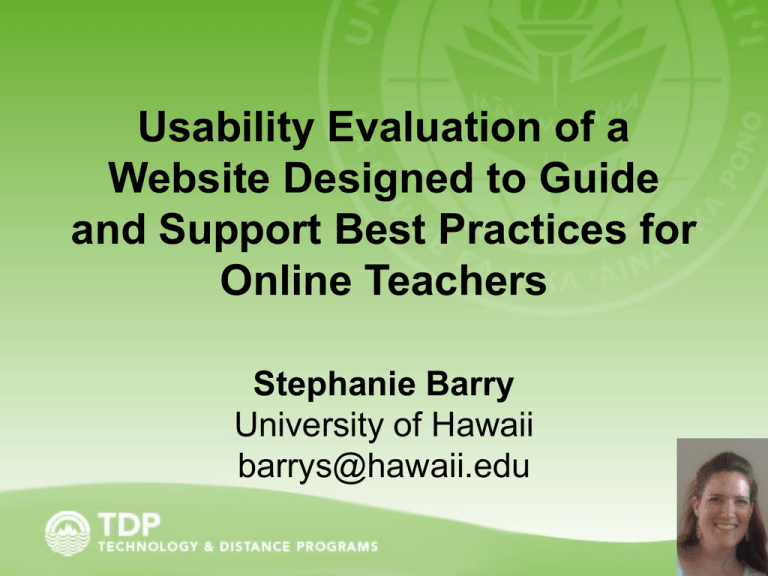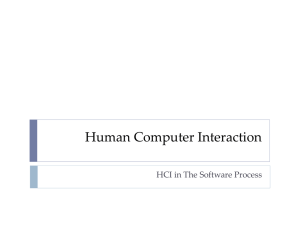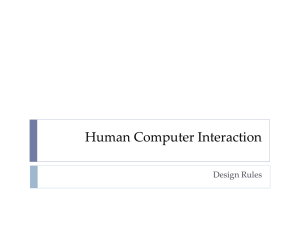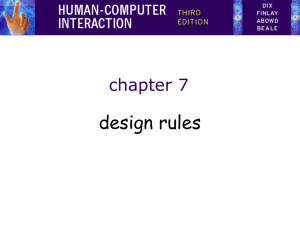ETEC-2011-Prese -Website-Usability-TCC
advertisement

Usability Evaluation of a Website Designed to Guide and Support Best Practices for Online Teachers Stephanie Barry University of Hawaii barrys@hawaii.edu Purpose To evaluate the content and usability of a site intended to support online teachers. Purpose To evaluate the content and usability of a site intended to support online teachers. Why? To help other institutions decide how to support faculty in online teaching, and provide a one-stop shop for best practices information and real-world examples. Background of TDP • Technology & Distance Programs Background of TDP • Technology & Distance Programs • Supports instructional technology Background of TDP • Technology & Distance Programs • Supports instructional technology • Serves the College of Education at the University of Hawaii Background of TDP • Technology & Distance Programs • Supports instructional technology • Serves the College of Education at the University of Hawaii • Provides workshops and consulting Rationale for Study • Data analysis • Gap in Online Teaching between: Rationale for Study • Data analysis • Gap in Online Teaching between: What is Rationale for Study • Data analysis • Gap in Online Teaching between: What is (frustration) Rationale for Study • Data analysis • Gap in Online Teaching between: What is (frustration) and Rationale for Study • Data analysis • Gap in Online Teaching between: What is (frustration) What should be: and Rationale for Study • Data analysis • Gap in Online Teaching between: What is (frustration) What should be: and Rationale for Study • Data analysis • Gap in Online Teaching What should be: • WASC Accreditation (CRAC, 2009) Rationale for Study • Data analysis • Gap in Online Teaching What should be: • WASC Accreditation (C-RAC, 2009) – Professional development Rationale for Study • Data analysis • Gap in Online Teaching What should be: • WASC Accreditation (C-RAC, 2009) – Professional development – Technical support Review of the Literature • Key Topics – Online teaching – Best Practices – Principles Review of the Literature • Key Topics – Online teaching – Best Practices – Principles • Combined the Lists Table 1 Principles of Effective Online Classes Table 1 Principles of Effective Online Classes Table 1 Principles of Effective Online Classes Table 1 Principles of Effective Online Classes Principles of Effective Online Classes Principles of Effective Online Classes These principles guided the site content Methods • Usability testing Methods • Usability testing • Look at the site • What do you notice first? • • • • Methods Usability testing Look at the site What do you notice first? I need a volunteer • • • • Methods Usability testing Look at the site What do you notice first? I need a volunteer Click on this button to raise your hand. The Site • Resources for Online Teachers Methods • Usability testing Methods • Usability testing – First impression Methods • Usability testing – First impression – Scenarios • Scenarios Methods – Video example • Scenarios Methods – Video example – http://tinyurl.com/usability-eval • Scenarios Methods – Video example – http://tinyurl.com/usability-eval • Watch video then return here (2 min) • Scenarios Methods – Video example – http://tinyurl.com/usability-eval • Watch video then return here (2 min) • What would you have looked for? – (type in the chat box) Results “There is no average user.” (Krug, 2005) Results • Content is great • Navigation can be improved • Site tour Discussion The Site • Resources for Online Teachers The Site • Resources for Online Teachers The Site • Resources for Online Teachers Multiple points of entry = The Site • Resources for Online Teachers Multiple points of entry = confusing The Site • Resources for Online Teachers The Site • Resources for Online Teachers The Site • Resources for Online Teachers The Site • Resources for Online Teachers What’s different? The Site • Resources for Online Teachers Needs dropdown The Site • Resources for Online Teachers What does “21st Century Course Planning Mean? • • • • Discussion Usability finds many problems Rhythm of the site (linking) Do “the least you can do” (Krug, 2009) Future: Google Sites and Analytics Questions? barrys@hawaii.edu • • • • • • • • • • • • • • • References Bloom, B. S. & Krathwohl, D. R. (1956). Taxonomy of educational objectives: The classification of educational goals, by a committee of college and university examiners. Handbook 1: Cognitive domain. New York, NY: Longmans. Center for Applied Special Technology. (2008). Universal design for learning guidelines version 1.0. Wakefield, MA: Author. Chang, C. S., Wong, W. T., Cheng Y. C. & Huang, Y. P. (2009). Usability evaluation in an exploratory design-based research approach of convenience store new employee training e-Learning material. Pervasive Computing (JCPC), 2009 Joint Conferences, 687 – 692. doi: 10.1109/JCPC.2009.5420096 Council of Regional Accrediting Commissions. (2009) Guidelines for the Evaluation of Distance Education (On-line Learning). Retrieved from www.wascsenior.org/ Gagne, R. M., Wager, W. W., Golas, K. C. & Keller, J. M. (2005). Defining performance objectives. In Principles of Instructional Design (pp. 132 – 150). Belmont, CA: Wadsworth. Graham, C., Cagiltay, K., Lim, B.-R., Craner, J. & Duffy, T. M. (2001). Seven principles of effective teaching: A practical lens for evaluating online courses. The Technology Source. Retrieved from http://ts.mivu.org/default.asp?show=article&id=839 Krug, S. (2005). Don’t make me think: A common sense guide to web usability (2nd ed.). Berkeley, CA: New Riders Press. Krug, S. (2009) Rocket surgery made easy: The do-it-yourself guide to finding and fixing usability problems. Berkeley, CA: New Riders Press. LaRose, R. & Whitten, P. (2000) Re-thinking instructional immediacy for web courses: A social cognitive exploration. Communication Education, 49(4), 320 – 338. doi: 10.1080/03634520009379221 Paloff, R. M. & Pratt, K. (2007). Building online learning communities (2nd ed.). San Francisco, CA: Jossey-Bass. Ragan, L. (2005). 10 principles of effective online teaching: Best practices in distance education. Christopher Hill, Ed. Distance Education Report. Madison, WI: Magna. Resnick, P.J., Janney, A.W., Buis, L.R. & Richardson, C.R. (2010). Adding an online community to an internetmediated walking program. Part 2: Strategies for encouraging community participation. Journal of Medical Internet Research, 12(4). Retrieved from http://www.jmir.org/2010/4/e72/ Van Duzer, J. (2002) Instructional design tips for online learning. Retrieved from www.csuchico.edu/celt/roi Vesely, P., Bloom, L., & Sherlock, J. (2007). Key elements of building online community: Comparing faculty and student perceptions. MERLOT Journal of Online Learning and Teaching, 3(3). Retrieved from http://jolt.merlot.org/vol3no3/vesely.pdf






